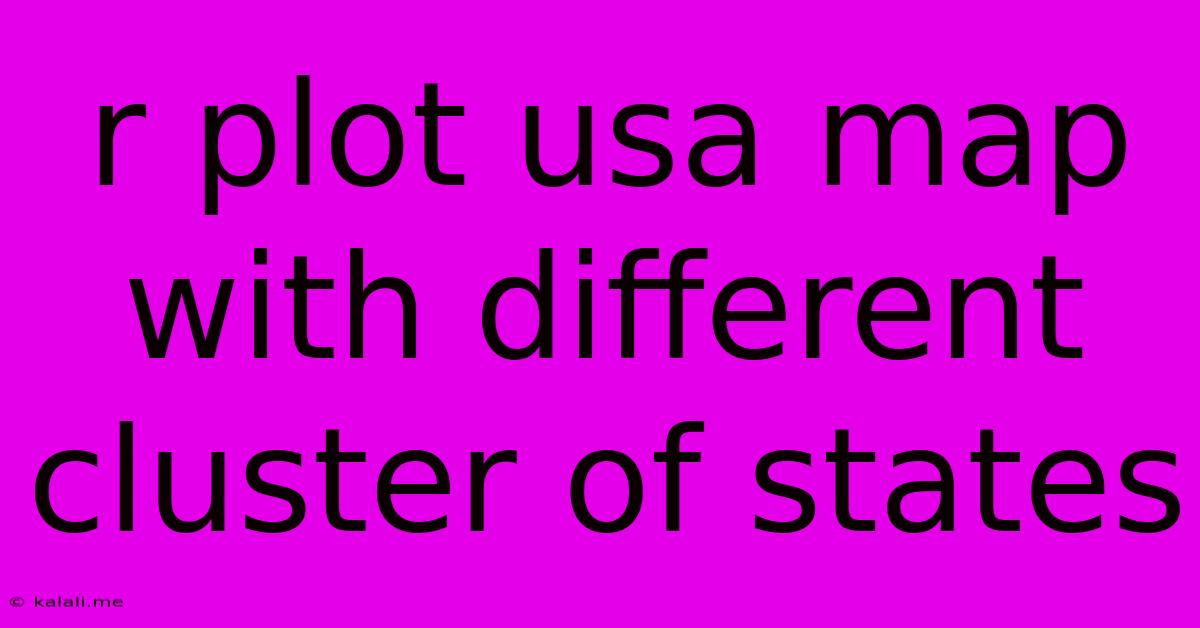R Plot Usa Map With Different Cluster Of States
Kalali
May 26, 2025 · 3 min read

Table of Contents
Plotting US State Clusters on a Map with R
This article will guide you through creating a visually appealing and informative map of the USA, colored according to different state clusters. We'll leverage R's powerful data visualization capabilities, specifically using the ggplot2 and usmap packages. This is ideal for showcasing results from clustering algorithms like k-means, hierarchical clustering, or community detection applied to US state data. The process involves data preparation, map creation, and customization for optimal presentation.
What you'll need:
- R: Ensure R is installed on your system.
- RStudio (recommended): A user-friendly interface for R.
- R Packages:
ggplot2,usmap, anddplyr(for data manipulation). You can install them using:install.packages(c("ggplot2", "usmap", "dplyr"))
Step 1: Data Preparation
The first crucial step is preparing your data. You'll need a data frame containing at least two columns:
- state: A column with the state names (or abbreviations). Ensure this matches the naming conventions used by the
usmappackage. - cluster: A column representing the cluster assignment for each state. This will dictate the color on your map.
Let's assume your data frame is named state_clusters. It might look something like this:
# Example data
state_clusters <- data.frame(
state = c("Alabama", "Alaska", "Arizona", "Arkansas", "California", "Colorado"),
cluster = c(1, 2, 1, 3, 1, 2)
)
Step 2: Creating the Map with ggplot2 and usmap
Now we can use ggplot2 and usmap to create the map. This code will generate a choropleth map, where each state is colored according to its cluster:
library(ggplot2)
library(usmap)
#Plot the map
plot_usmap(data = state_clusters, values = "cluster", color = "black") +
scale_fill_continuous(low = "lightblue", high = "darkblue", name = "Cluster", na.value = "grey") +
labs(title = "US State Clusters", subtitle = "Clustering Results Visualization") +
theme(legend.position = "right")
This code first loads the necessary libraries. plot_usmap creates the base map, associating the cluster column with the fill color. scale_fill_continuous specifies the color gradient, and labs adds a title and subtitle. theme adjusts the legend position. Experiment with different color palettes to find one that best suits your data and presentation style. You can also use scale_fill_viridis_d() for a perceptually uniform color scale.
Step 3: Handling Missing Data
If your state_clusters data frame doesn't include all 50 states, you might encounter missing values. The na.value argument in scale_fill_continuous handles this by assigning a specific color (grey in this example) to states not present in your cluster results. Alternatively, you can pre-process your data to include all states with a designated "NA" or "0" cluster assignment.
Step 4: Advanced Customization
You can further customize your map with:
- Different color palettes: Explore various color scales provided by
RColorBreweror other packages for better visual distinction between clusters. - Adding labels: Display state names or cluster numbers directly on the map for enhanced clarity.
- Interactive maps: For more interactive visualizations, consider using packages like
plotly. - Geographic projections: Change the map projection for a different perspective.
By following these steps, you can effectively visualize your US state clusters using R, creating compelling visuals for presentations, reports, or publications. Remember to clearly label your axes and provide a concise legend to ensure the map is easily interpretable. Experiment with the code and adjust parameters to tailor the map to your specific needs and data. This detailed approach will help you create impactful and insightful visualizations of your state clustering analysis.
Latest Posts
Latest Posts
-
How Many Cups Are In 3 Quarts Of Water
Jun 30, 2025
-
25 Cents A Minute For An Hour
Jun 30, 2025
-
In Music What Does Allegro Mean Math Answer Key Pdf
Jun 30, 2025
-
What Is 1 5 Of A Tablespoon
Jun 30, 2025
-
How Long Does It Take To Drive Through Illinois
Jun 30, 2025
Related Post
Thank you for visiting our website which covers about R Plot Usa Map With Different Cluster Of States . We hope the information provided has been useful to you. Feel free to contact us if you have any questions or need further assistance. See you next time and don't miss to bookmark.